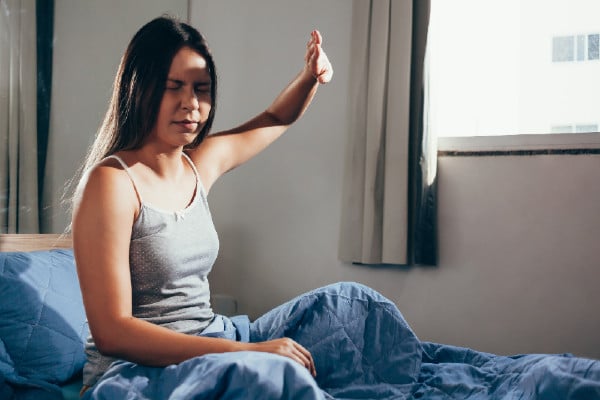Photophobia is a sensitivity or pain with exposure to light. People with light-coloured eyes or larger pupils tend to be naturally more sensitive to light. However, photophobia may be associated with many different eye conditions, some requiring urgent attention.

Photophobia may commonly be associated with:
- Eye infection or inflammation
- Contact lens irritation
- Dry eye
- Eyestrain
- Migraine
- Cataract
- Medications
- Corneal abrasion
Eye infection / inflammation / contact lens irritation
Suppose you have:
- contact lens irritation
- very red eye
- painful eye
- light-sensitive eye
- watery or sticky discharge from the eye
You should remove any contact lenses you are wearing and see your optometrist as soon as possible. It may be necessary to take a course of drops to remove the infection or reduce the inflammation.
Dry Eye
Dry eye symptoms can include photophobia.
Symptoms can be managed using any, or a combination of the following:
- preservative-free drops or gel
- warm compresses held against the closed eyelids
- gentle lid massage
These are just a few ways to reduce photophobia caused by dry eye.
Eyestrain
Spending hours on devices, as we all do in this day and age, can lead to eyestrain, which may cause photophobia in some people.
Eye strain can be managed by the following:
- Making sure that your spectacle prescription is up to date
- Be sure to wear any required spectacles when using digital devices
- Take regular breaks from the screen
This can all help reduce photophobia caused by eyestrain.
Migraine
Migraine sufferers can have many different visual symptoms at the onset, including:
- visual auras
- colours
- floaters
- blurry patches
- photophobia
Also, the visual symptoms of a migraine can occur without the headache, which is called an ocular migraine.
It is essential to have these symptoms checked by an optometrist as soon as possible to rule out any problems at the back of the eye.
Cataract
A cataract is when the lens inside the eye goes cloudy and is very common over the age of 70. Cataracts may cause blurry vision in one eye, double vision, “halos” around lights, problems with night vision, and photophobia. Early cataracts may not need any treatment or a change in spectacle prescription. For more advanced cataracts, surgery to remove and replace the eye’s lens is very effective.
Medications
Certain medications such as tetracycline and doxycycline (antibiotics) or atropine (a drop used to prevent the progression of short-sightedness in children) can also trigger photophobia. Other medications that may cause photophobia include ibuprofen, naproxen, methotrexate.
Corneal abrasion/foreign body
Corneal abrasion, such as a scratch to the front surface of the eye, or a foreign body in the eye, such as a small piece of dirt or metal in the eye, could cause irritation, watering, pain, and photophobia. Please see your optometrist immediately for removal of the foreign body and antibiotic cover. The photophobia will subside once the foreign body is removed, or the abrasion has healed.
Eye rubbing
It is crucial to avoid rubbing the eyes! People with photophobia will often rub their eyes in an attempt to alleviate the glare. However, rubbing the eyes can risk further injury if the photophobia is due to a corneal abrasion or foreign body. Touching the eyes can also encourage infection. Keratoconus is a condition that can result from vigorous eye rubbing, causing the cornea, or front surface of the eye, to bulge forward, causing vision to blur. This condition may be corrected with spectacles in mild cases, but in moderate to severe cases may only be corrected with specialty hard contact lenses or even a corneal graft.
Get your eyes checked
In very rare instances,serious brain conditions such as meningitis and encephalitis may also cause photophobia. It is therefore, imperative to have your eyes checked, as soon as possible if you suddenly experience any photophobia, eye pain or headache, to rule out any serious underlying conditions. Contact us to arrange an appointment.
















